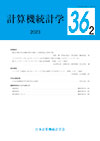Volume 36, Issue 2
Displaying 1-13 of 13 articles from this issue
- |<
- <
- 1
- >
- >|
-
2023Volume 36Issue 2 Pages Cover1-
Published: 2023
Released on J-STAGE: January 11, 2024
Download PDF (129K) -
2023Volume 36Issue 2 Pages App1-
Published: 2023
Released on J-STAGE: January 11, 2024
Download PDF (117K) -
2023Volume 36Issue 2 Pages i-
Published: 2023
Released on J-STAGE: January 11, 2024
Download PDF (63K) -
2023Volume 36Issue 2 Pages ii-
Published: 2023
Released on J-STAGE: January 11, 2024
Download PDF (32K)
original papers
-
2023Volume 36Issue 2 Pages 83-97
Published: 2023
Released on J-STAGE: January 11, 2024
Download PDF (1095K) -
2023Volume 36Issue 2 Pages 99-126
Published: 2023
Released on J-STAGE: January 11, 2024
Download PDF (1400K)
Reviews
-
2023Volume 36Issue 2 Pages 127-144
Published: 2023
Released on J-STAGE: January 11, 2024
Download PDF (861K)
Report of Activities
-
2023Volume 36Issue 2 Pages 145-159
Published: 2023
Released on J-STAGE: January 11, 2024
Download PDF (490K)
Editorial Board
-
2023Volume 36Issue 2 Pages 161-
Published: 2023
Released on J-STAGE: January 11, 2024
Download PDF (148K) -
2023Volume 36Issue 2 Pages 162-
Published: 2023
Released on J-STAGE: January 11, 2024
Download PDF (145K) -
2023Volume 36Issue 2 Pages 163-
Published: 2023
Released on J-STAGE: January 11, 2024
Download PDF (131K)
-
2023Volume 36Issue 2 Pages App2-
Published: 2023
Released on J-STAGE: January 11, 2024
Download PDF (105K) -
2023Volume 36Issue 2 Pages Cover2-
Published: 2023
Released on J-STAGE: January 11, 2024
Download PDF (133K)
- |<
- <
- 1
- >
- >|
